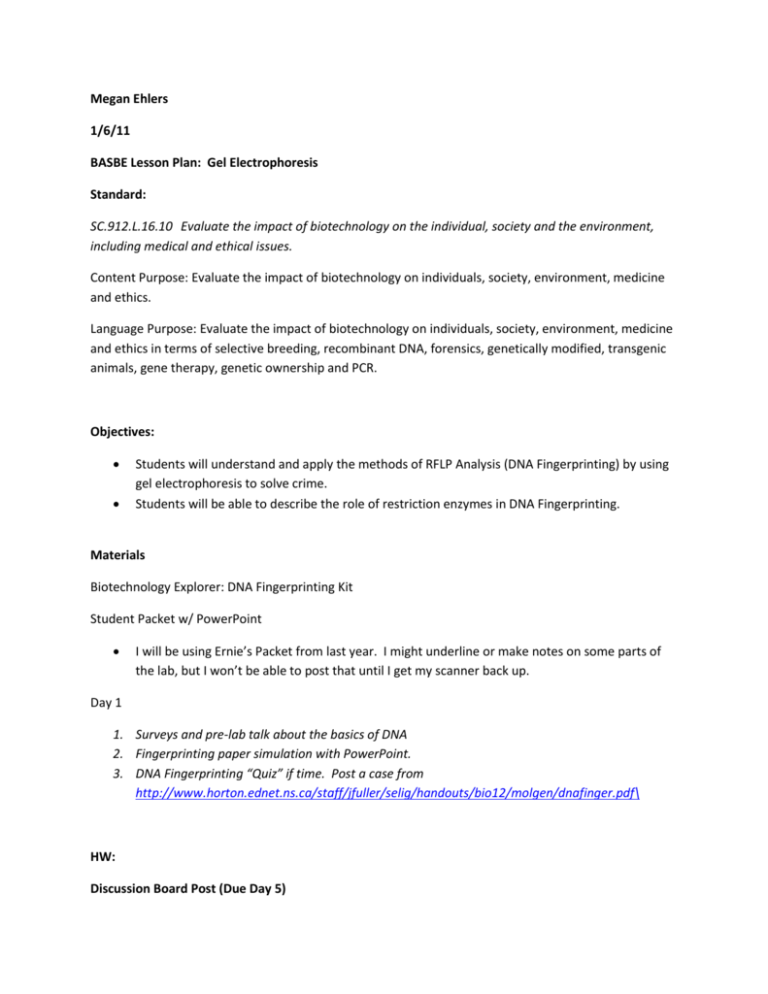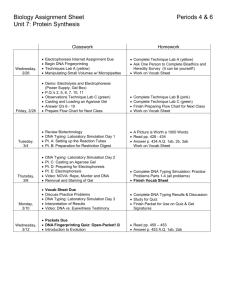DNA Fingerprinting Lesson Plan
advertisement

Megan Ehlers 1/6/11 BASBE Lesson Plan: Gel Electrophoresis Standard: SC.912.L.16.10 Evaluate the impact of biotechnology on the individual, society and the environment, including medical and ethical issues. Content Purpose: Evaluate the impact of biotechnology on individuals, society, environment, medicine and ethics. Language Purpose: Evaluate the impact of biotechnology on individuals, society, environment, medicine and ethics in terms of selective breeding, recombinant DNA, forensics, genetically modified, transgenic animals, gene therapy, genetic ownership and PCR. Objectives: Students will understand and apply the methods of RFLP Analysis (DNA Fingerprinting) by using gel electrophoresis to solve crime. Students will be able to describe the role of restriction enzymes in DNA Fingerprinting. Materials Biotechnology Explorer: DNA Fingerprinting Kit Student Packet w/ PowerPoint I will be using Ernie’s Packet from last year. I might underline or make notes on some parts of the lab, but I won’t be able to post that until I get my scanner back up. Day 1 1. Surveys and pre-lab talk about the basics of DNA 2. Fingerprinting paper simulation with PowerPoint. 3. DNA Fingerprinting “Quiz” if time. Post a case from http://www.horton.ednet.ns.ca/staff/jfuller/selig/handouts/bio12/molgen/dnafinger.pdf\ HW: Discussion Board Post (Due Day 5) (Articles taken from http://www.pleasanton.k12.ca.us/avhsweb/thiel/bio/labs/csi.html) Part I. The following articles contain two very different stories about how DNA fingerprinting is used in criminal investigation. Read both and write a comparison that includes your opinions: http://www.cbsnews.com/stories/2006/01/12/national/main1205921.shtml http://www.cbsnews.com/stories/2006/01/12/national/main1205921.shtml Part II. Alec Jeffreys discovered DNA fingerprinting over twenty years ago. Read the article below to find out his concerns about the technology he brought into the world. For your summary, list his concerns and your own beliefs about this biotechnology. http://www.chinadaily.com.cn/english/doc/2004-09/09/content_373113.htm Day 2 1. Micropipette practice. 2. Set up the restriction digest. 3. Gel Electrophoresis online simulation( if time permits). a. http://learn.genetics.utah.edu/content/labs/gel/ b. Questions for the animation. 1. 2. 3. 4. 5. 6. 7. 8. 9. What is gel electrophoresis used for? Describe how the length of DNA fragments determines how far they will move across the gel. What is the purpose of the comb? Why is the loading buffer needed? Explain the purpose for a DNA standard. DNA has a _______________ charge. What charge is closest to the wells? Describe how the charge of effects DNA movement across the gel. A fragment of DNA has 2000 bp. What does “bp” stand for? Day 3 1. Add loading dye to samples/load and run gels. HW: DNA Fingerprinting Worksheet - NOVA (At the end of this lesson plan) http://www.pbs.org/wgbh/aso/resources/guide/earthappenact3.html Day 4 1. Students view gels. 2. Post lab analysis. 3. DNA Profiling Simulation (if time) a. Students choose between investigating a crime scene or paternity dispute. b. http://www.biotechnologyonline.gov.au/popups/int_dnaprofiling.html Extras Article: Can DNA Demand a Verdict? o Article describing the analysis and uses of DNA fingerprinting. o http://learn.genetics.utah.edu/content/labs/gel/forensics/ NOVA: Create a DNA Fingerprint (Can be downloaded) o Online simulation where students use DNA fingerprinting to determine who stole lollipop. o Discussion Questions: Describe the process of DNA fingerprinting. In what ways is it like actual fingerprinting and in what ways is it different? How conclusive is the evidence of DNA fingerprinting? Where is there possibility for error? o Background Essay also available on Teacher’s Domain Website o http://www.teachersdomain.org/resource/tdc02.sci.life.gen.creatednafingerprint/ DNA "Fingerprinting" Worksheet In this hypothetical paternity case, four autoradiographs show DNA "fingerprints" taken from three individuals: a mother, her child, and the child's alleged father. Each autoradiograph compares equivalent DNA segments from the three individuals. The two dark bands in each column represent one individual's DNA segments -- one inherited from that individual's biological mother and the other from the biological father. These segments differ in length from person to person; for this reason they are used as genetic markers. Here, each length is designated by a letter, A through O. The two letters associated with each segment indicate the individual's genotype. Instructions 1. Under each column in the autoradiograph, write the letters associated with each individual's genotype. For example, the genotype of the mother in the first column is A/D. Then, circle the letter in the child's genotype that represents the gene inherited from the mother. 2. Which "letters" must the child have inherited from its father? 3. Based on this information, what evidence suggests that the alleged father could be biologically related to the child?







